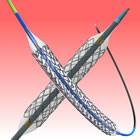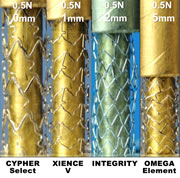|
The DUTCH PEERS trial (DUrable polymer-based sTent CHallenge of Promus ElemEnt versus ReSolute integrity) studied 1,811 patients with 2,371 target lesions in their coronary arteries. The patients were enrolled during the period 2010-2012 at four study sites in The Netherlands and randomized to either Medtronic's cobalt-chromium-based Resolute Integrity zotarolimus-eluting stent or Boston Scientific's platinum-chromium-based Promus Element everolimus-eluting stent.
The principal investigator was Clemens von Birgelen, M.D., Ph.D., co-director of the Department of Cardiology at Thoraxcentrum Twente and professor of cardiology at the University of Twente in the Netherlands. Dr. von Birgelen previously headed the TWENTE trial, which compared two second-generation stents: the Medtronic Resolute and the Abbott Xience V. The results of that trial showed no difference between the two stents. This most recent comparison, the DUTCH PEERS trial, has in fact been dubbed TWENTE II. Third Generation Stents: It's the Platform!
So one of the reasons for DUTCH PEERS was to assess the safety and efficacy of these new structural platforms. The main twelve month endpoint was Target Vessel Failure (TVF): a composite of cardiac death, target-vessel-related myocardial infarction, and clinically-driven target-vessel revascularization (TVR). Physicians also "were requested to report any evident or suspected longitudinal stent deformation, which was defined as distortion or shortening of an implanted stent in the longitudinal axis after initially successful deployment." A feature of DUTCH PEERS is that it is the first randomized study of Medtronic's new Resolute Integrity DES platform (Medtronic's Resolute global clinical trial program of over 5,100 patients looked at a Resolute stent that was built upon an earlier second generation stent structure). The Integrity platform is unique, utilizing a continuous sinusoid technology which enables each stent to be made from a single wire, comparable to a flexible spring. The company claims that "coupled with the MicroTrac delivery system, this engineering advance offers exceptional deliverability without compromising other important stent design characteristics like radial strength." Boston Scientific's Promus Element is based on the Omega Element laser-cut platform, featuring a platinum alloy that is flexible and offers increased visibility under fluoroscopy. Results of DUTCH PEERS (TWENTE II) The equivalence of the two stents was seen across all the subgroups. There were no differences in clinical outcomes. Also encouraging was that the number of events was smaller than expected for an "all comers" type trial. 20% of the patients enrolled presented with ST-elevated Myocardial Infarction (STEMI), the most serious type of heart attack. Another 25% presented with NSTEMI. There were many complex lesions, considerable multivessel disease and narrow vessels (50% were < 2.7mm). And while this was a small number of centers, located in a single country, the follow-up by the investigators was 100%. No patient's data was lost, a very important issue when dealing with trials of these advanced devices where event rates are very low. There was, however, one parameter in which the two stents were not the same: longitudinal stent deformation. Longitudinal Stent Deformation (LSD)
Such deformation has been reported in the past, most often with stents utilizing Boston Scientific's Omega Element design. A 2011 study, published in JACC: Interventions, subjected seven stent designs to laboratory bench-testing for resistance to compression. The Element design was seen as the most susceptible to deformation. Dr. von Birgelen told Angioplasty.Org that, although this type of stent deformation has been previously seen in registries, DUTCH PEERS is the only randomized trial to measure these events in a real world clinical setting. The results were that no stent deformations were seen in any of the Resolute Integrity cases, but nine (1%) were measured among those who received the Promus Element, for a statistically significant p value of 0.002. None of these instances resulted in any adverse clinical events because they were addressed during the procedure by inflating a balloon and re-expanding the stent. In seven of the nine cases, an additional proximal stent was also placed. Left unrepaired, a deformed stent might give rise to increased future restenosis. But Dr. von Birgelen emphasized to Angioplasty.Org that, while this type of stent deformation caused no problems, operators should be aware of it, learn how to recognize it, and how to deal with it should it occur. Two points about longitudinal stent deformation: (1) repairing a deformed section of the stent is not complex, but does require an additional balloon, possibly an additional overlapping stent, therefore somewhat higher costs, and longer procedural time, therefore slightly greater radiation exposure; and (2) a reason for the increased incidence of longitudinal stent deformation seen in the Promus Element, cited both by the authors and also in the accompanying commentary by Drs. Robert A Byrne and Adnan Kastrati of Munich, may be that the Element stent is significantly more radiopaque, more visible under fluoroscopy, and so deformation is more easily observed. It is possible, they note, that other stents may have this same problem, but it's not observed under fluoroscopy as easily. This explanation may be correct, although the bench-tests did show the Element less able to withstand compression forces. The bottom line, however, was that longitudinal stent deformation was a relatively low frequency event and that, when addressed promptly, caused no adverse clinical outcomes. Implications for the U.S. Stent Market Physicians in the U.S. currently have a choice of several very similar stents. As shown by the DUTCH PEERS, the original TWENTE study and others, all these devices provide excellent outcomes. As Dr. Ron Waksman of the Washington Hospital Center has commented to Angioplasty.Org, physician choice ultimately may come down to pricing, availability of stent sizes and personal preferences. Reported by Burt Cohen, February 11, 2014 |



